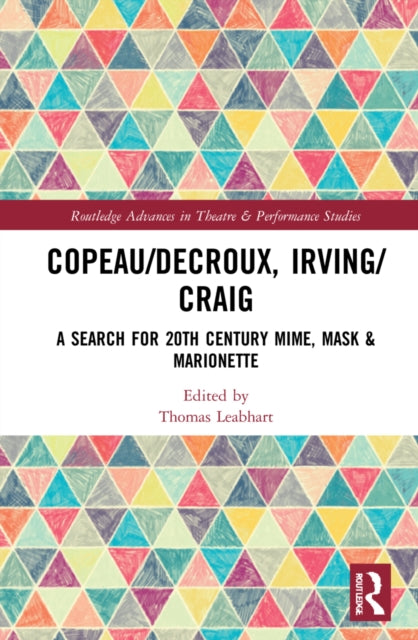Thomas Leabhart
Copeau/Decroux, Irving/Craig: A Search for 20th Century Mime, Mask & Marionette
Copeau/Decroux, Irving/Craig: A Search for 20th Century Mime, Mask & Marionette
YOU SAVE £6.96
- Condition: Brand new
- UK Delivery times: Usually arrives within 2 - 3 working days
- UK Shipping: Fee starts at £2.39. Subject to product weight & dimension
Bulk ordering. Want 15 or more copies? Get a personalised quote and bigger discounts. Learn more about bulk orders.
Couldn't load pickup availability
- More about Copeau/Decroux, Irving/Craig: A Search for 20th Century Mime, Mask & Marionette
A book about the theatre history of the 20th century is useful for actors, object animators, directors, devisers, and collective creators. It is also good for theatre anthropologists.
Format: Hardback
Length: 174 pages
Publication date: 12 May 2022
Publisher: Taylor & Francis Ltd
Here is the rephrased text:
The book "Theatre of the Absurd: A Study of the Theatre of the Absurd in the 20th Century" is a comprehensive exploration of the theatrical phenomenon known as the Theatre of the Absurd. Authored by renowned theatre scholar Martin Esslin, this seminal work delves into the origins, development, and impact of this unique theatrical style, which emerged in the mid-20th century.
The Theatre of the Absurd is characterized by its rejection of traditional narrative structures and its emphasis on the exploration of the human condition. It challenges the audience to question their assumptions about reality and to consider the absurdity of existence. Through its use of surrealism, symbolism, and non-linear storytelling, the Theatre of the Absurd creates a sense of confusion and disorientation, leaving the audience with a profound sense of introspection.
This book is of immense interest to actors and object animators, as it provides valuable insights into the techniques and approaches required to perform in the Theatre of the Absurd. It is also useful for directors, devisers, and collective creators, as it offers a new way of looking at the theatre history of the 20th century. Moreover, this book is a valuable resource for Theatre Anthropologists, as it provides a deep understanding of the cultural and social implications of the Theatre of the Absurd.
The Theatre of the Absurd emerged in the mid-20th century as a response to the perceived limitations and constraints of traditional theatrical forms. It was born out of a desire to break free from the traditional storytelling structures and explore the deeper aspects of the human condition. The Theatre of the Absurd was characterized by its use of surrealism, symbolism, and non-linear storytelling, which created a sense of confusion and disorientation in the audience.
One of the key features of the Theatre of the Absurd was its rejection of traditional narrative structures. Instead of following a linear plot, the plays of the Theatre of the Absurd often featured characters who were trapped in a cycle of absurdity, unable to escape their circumstances. This non-linear approach to storytelling created a sense of confusion and disorientation in the audience, as they were unable to predict what would happen next.
Another hallmark of the Theatre of the Absurd was its use of surrealism. Surrealism is a visual and literary style that seeks to depict the irrational and illogical aspects of the human experience. In the Theatre of the Absurd, surrealism was used to create a sense of the absurdity of existence. Plays featured characters who were trapped in a world that was often nonsensical and irrational, and who were unable to make sense of their surroundings.
Symbolism was also a key element of the Theatre of the Absurd. Symbols were used to represent the deeper meanings and meanings of the plays, and to create a sense of ambiguity and mystery. For example, a symbol of a bird could represent freedom, or it could represent imprisonment. This use of symbolism.
Non-linear storytelling was another technique used by the Theatre of the Absurd to create a sense of confusion and disorientation in the audience. Plays often featured multiple storylines.
The Theatre of the Absurd was a groundbreaking theatrical style that had a significant impact on the world of theatre. It challenged the traditional storytelling structures and explored the deeper aspects of the human condition. Through its use of surrealism, symbolism, and non-linear storytelling, the Theatre of the Absurd created a sense of confusion and disorientation in the audience, leaving them with a profound sense of introspection.
The Theatre of the Absurd continues to be a popular theatrical style today, and its influence can be seen in many contemporary plays and films. Its legacy continues to inspire new generations of artists and thinkers, who are exploring the boundaries of what is possible in the world of theatre.
Weight: 500g
Dimension: 234 x 156 (mm)
ISBN-13: 9781032071817
This item can be found in:
UK and International shipping information
UK and International shipping information
UK Delivery and returns information:
- Delivery within 2 - 3 days when ordering in the UK.
- Shipping fee for UK customers from £2.39. Fully tracked shipping service available.
- Returns policy: Return within 30 days of receipt for full refund.
International deliveries:
Shulph Ink now ships to Australia, Belgium, Canada, France, Germany, Ireland, Italy, India, Luxembourg Saudi Arabia, Singapore, Spain, Netherlands, New Zealand, United Arab Emirates, United States of America.
- Delivery times: within 5 - 10 days for international orders.
- Shipping fee: charges vary for overseas orders. Only tracked services are available for most international orders. Some countries have untracked shipping options.
- Customs charges: If ordering to addresses outside the United Kingdom, you may or may not incur additional customs and duties fees during local delivery.


